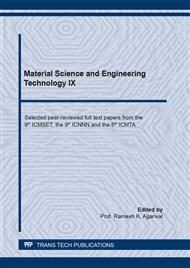p.21
p.29
p.37
p.45
p.53
p.61
p.69
p.75
p.83
Effects of Oxide Inclusions on Texture of 1235 Al-Alloy after Deformation
Abstract:
Texture characteristics of compressed 1235 Al-alloy treated by different purification methods are studied by electron backscattered diffraction. The effects of oxide inclusions on texture components of material are studied as well. The main textures in hot-compressed 1235 Al-alloy are Cube texture, R texture, Gross texture, Brass texture, and Rotated cube texture. The lower the content of oxide inclusions in the material, the smaller the total relative ratio of textures. The total relative ratio of textures goes to the smallest by 1.8 % in high-efficient purified 1235 Al-alloy by oxide inclusion content of 0.051 %. The purification results have obvious effects on types and percentage of texture in the deformed alloy. With the decreasing content of oxide inclusion, the ratio of deformation texture decreases and recrystallization texture increases. Brass texture is gradually replaced by Goss texture in the deformation textures. R texture is the main texture in recrystallization textures. Therefore, reducing the content of oxide inclusions is effective for improving the hot deformation properties of 1235 Al-alloy.
Info:
Periodical:
Pages:
53-59
Citation:
Online since:
March 2021
Authors:
Price:
Сopyright:
© 2021 Trans Tech Publications Ltd. All Rights Reserved
Share:
Citation:


